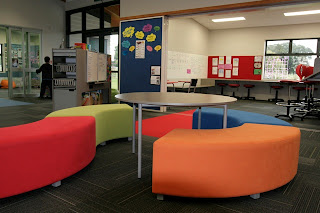Little did we know a year ago when ten of us sat around in the staffroom talking about open learning spaces that twelve months later the Professional Learning Group would grow so quickly. So it was wonderful to see 42 teachers gather at Freemans Bay School to talk learning and spaces. And in a wave of trans-Tasman collaboration it was wonderful to also welcome Erin, skyping in from Canberra. Word is obviously spreading! It’s great to see so many new schools also getting involved and the network widening. There’s a real interest in looking at how to maximize the opportunities presented by new learning environments.
Freemans Bay School has recently added a new learning block, with five teaching spaces and a shared awhina area, furnished and utilized as a breakout space. A video that some students had made shared how they use the new space and the new furniture as part of their day. They talked of comfortable furniture and being able to make decisions about where they were learning.
The nature of learning spaces at the school has evolved from open plan to more traditional classrooms over the years, and now sees a transformation to modern learning environments. It’s an evolution that’s set to continue for a while with a lot more building on its way. A combination of subsidence, asbestos and leaky buildings has meant that essentially the school is, over the course of the next couple of years, going to be reconstructed. It represents a real opportunity for the school to look at what learning and teaching spaces might look like.
Collaboration formed the main theme of the afternoon with World Café style groups looking at what enhances and what forms barriers to teacher collaboration in open learning spaces. Interestingly the more the dialogue around new learning and teaching environments develop, the more emphasis is being placed on the teaching practice that goes on within the space rather than the space itself. Space can certainly act as an enabler if designed well but it’s what happens within it that really matters. And it’s the nature of teacher-teacher collaboration, those crucial interrelationships that become really key. This was very much reflected in the pluses and minuses that were raised:
What enhances collaboration?
· Having a shared belief and understanding- teachers, students & community- are we all kicking the ball in the same direction?
· Teacher relationships with each other – what organizational norms do we need in place to develop the high level of trust necessary?
· Teachers learning from each other, the notion of incidental professional development- we can learn so much from each other
· Teachers utilizing their own, and each other’s strengths- how can we build on these?
What are the barriers?
· A lack of understanding as to how to run shared spaces- what are the systems underpinning shared spaces and the common pedagogy required?
· Teacher’s mind set- What if some people don’t buy into the notion of an open, shared space?
· Communication- How do you ensure teacher-teacher and teacher-student communication is optimized?
· Responsibility for students in a shared space- Whose is it?
· Teacher’s attitudes and willingness to explore new opportunities- what if some are more willing than others?
· Community attitudes- previous experiences people bring with them- have they seen it all before?
This is really healthy dialogue to be involved in and certainly there are themes here that will be common to the many schools present exploring new concepts of learning spaces. The PLG offers real diversity in terms of peoples experiences and ideas around learning environments and it’s great to be able to have a forum in which to share them.
Of the barriers that emerge, many I suspect are barriers to good teaching and learning regardless of the nature of the space. They are all about mindsets, communication, relevant pedagogy and ideas of ownership- both of place and people. Decades of teachers working in isolation in single cell environments has undoubtedly entrenched some notions of ‘my space’ and ‘my class’ and many aspects of open and shared learning environments challenge some of these practices. New spaces might well act as a catalyst to change but change won’t be sustained without shared belief and sincere collaboration.
So where to next? As we move forward with the PLG group this year the dialogue around collaboration will no doubt continue and deepen. It’s certainly one of the reoccurring themes that bubblesup. The next get together will be on June 7th and hosted at Hingaia Peninsula School. A great chance to look at some new spaces and to see how students and teachers are using them. Register your interest here.
Thanks to Freemans Bay for being such great hosts, to everyone who came along, and to Furnware for supplying the afternoon tea.









